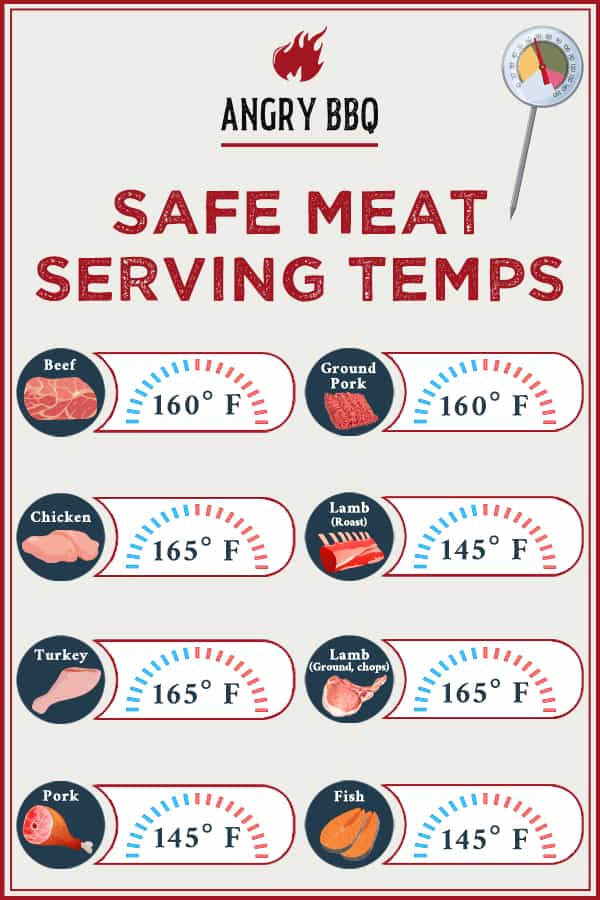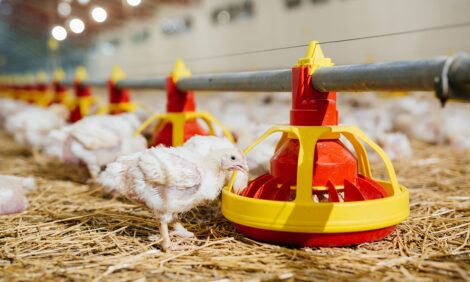



Ready to BBQ: safe meat serving temperatures

If you put in a lot of time trying to grill a piece of meat to perfection, it can be particularly disconcerting if you cut it open and find it still raw or undercooked. Getting the meat to the right temperature while grilling and smoking can be important not only from a flavor and texture standpoint but also in terms of food safety. Raw or undercooked meat can make you severely ill and can even cause death in certain cases.
Therefore, it is important to put in some time and effort and learn about safe meat serving temperatures so you can get those pieces of meat perfectly cooked every time on your grill.
Chicken
Completely overcooking your chicken can make it dry and grainy, but it is especially important not to undercook it. Raw chicken often contains bacteria that can cause food poisoning if the meat is not cooked through. There have even been cases of salmonella poisoning which can sometimes be fatal.
This can be easily prevented by cooking the chicken through and through. All you need to do is ensure that your chicken reaches an internal temperature of 165 degrees. If you are cooking a thick piece of chicken or a whole chicken, you can insert a probe into the thickest part of it to ensure that it reaches the optimum temperature and the whole piece is cooked through.
Different parts of the chicken might cook at different speeds as well. Generally, white meat takes less time to cook than dark meat. If you are grilling a batch of chicken, you might consider throwing the thighs and legs on the grill first and then add the chicken breasts once some time has passed so that they all end up done at the same time.
The exact same rules also apply for turkey.
Beef
Beef is often consumed medium or rare and can be difficult to get right on the grill. With most cuts of beef, a safe internal temperature would be 160 degrees. Anything below 145 degrees might end up being unsafe. Tougher cuts can become tender with low and slow cooking, while something like a tenderloin or fillet can be cooked quickly over high heat, provided the right internal temperature is reached.
The temperature continues to rise, and the meat continues to cook while it is resting. It is important to include this in your calculations while cooking beef. A common recommendation is to let the meat rest for as long as it was cooked so that the heat can permeate the meat and the interior parts can come up to the right temperature. You can also prevent the steak from bleeding when cut if you give it enough rest.
Since beef can be a challenge to cook just right, the use of a food thermometer can make things much easier. Stick the probe into the thickest part of the cut and monitor the temperature throughout the cooking and resting process.
Pork
Cooking pork is always a challenge. While cuts like pork ribs or tenderloin medallions can reach the right internal temperature quickly, a thick-cut pork chop might take a very long time to get up to temp. A minimum internal temperature of 145 degrees is recommended in most cases. If you are cooking ground pork like a burger patty, you should aim for 160 degrees.
As it is with most thick cuts, putting your probe in the thickest part of the cut is a great way to ensure that you get accurate temperature readings. It is easy to be misled with a thick cut of pork. The outside might be cooked but the meat can still be raw inside if not given enough time to come up to temperature.
If you are looking to enjoy a good pork roast or tenderloin, a good rule of thumb is to give it 25 minutes of cook time per pound with the temperature close to 375 degrees. This can help the cut reach the right internal temperature while keeping it tender and moist. Overcooked pork becomes tough and chewy. I find that most people overcook pork and having an instant read meat thermometer is extremely helpful to determine when the pork is done. Our pork tenderloins are so much better, now that we use an instant read thermometer.
Lamb
Lamb needs careful handling if you want to enjoy the best flavor and texture while also remaining safe. For a lamb roast or rack, an internal temperature of 145 degrees should be fine. However, you should be aiming at 165 degrees while cooking lamb chops or ground lamb. This is because any harmful bacteria in the lamb is likely to be near the surface of the meat and only thorough cooking can neutralize it.
If you are cooking lamb patties or cubes, they need to be completely cooked through. A lamb roast can be left a little rare according to taste if you develop a hard sear on the outside by getting it hot enough.

Fish
Delicate fish can take some practice to get right on the grill. Due to the delicate and flaky nature of the meat, it is quite common for people to undercook fish. In the case of most fish, it is recommended that you reach an internal temperature of 145 degrees to stay safe.
This can be achieved with some practice, especially if you are cooking something like a salmon fillet. After cooking, give it some rest and cut it open to check if you have reached the right internal temperature.
Since fish is often consumed raw in the form of sashimi or sushi, it is important to source it from a trusted seller if you want to avoid infection. Raw fish can be a bad idea for children and pregnant women due to the potential for Listeria contamination. Giving your fish enough time on the grill or in the pan can ensure that it gets cooked through.
Cooking Properly
The hazards of uncooked or undercooked meat are very real. There can be several health complications resulting from the consumption of meat that has not been properly cooked. However, everything should be fine if you maintain the minimum internal temperatures mentioned here.
A probe thermometer can be your friend while cooking meat, helping you monitor temperatures along the way. It might take a bit of practice to strike the perfect middle ground between undercooked, dangerous meat and overcooked, unpalatable meat. However, the effort would certainly be worth it as you can end up with perfectly cooked, tender, and juicy meat every time.








